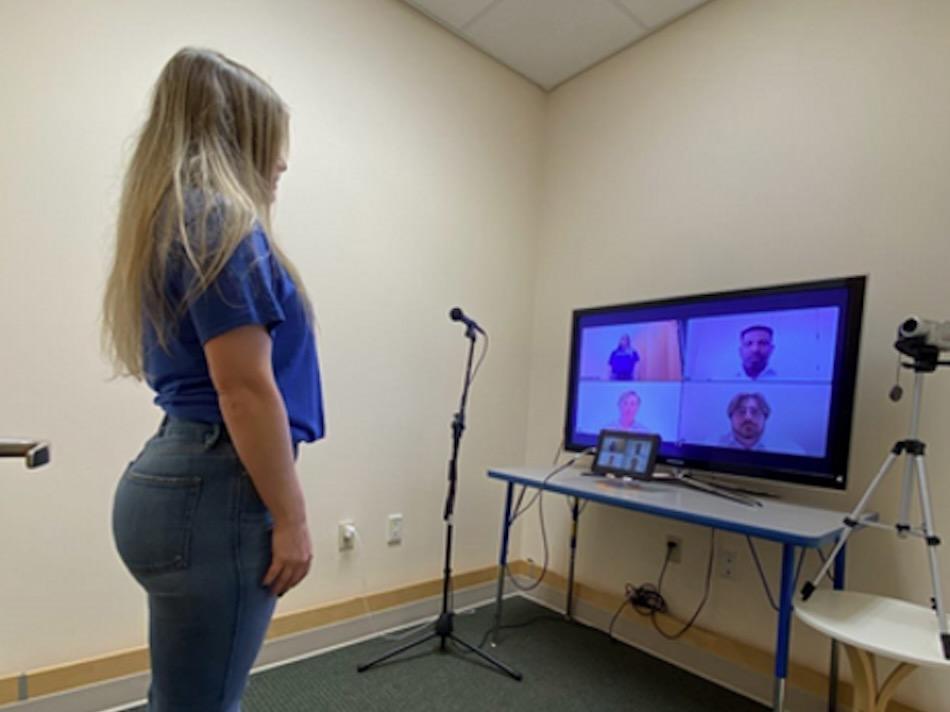
When Dr. Frances Champagne and her team at The University of Texas at Austin set out to study stress, they didn’t expect a global pandemic to reshape their methods. But the result — a semi-virtual version of a gold-standard stress protocol — could reshape the field itself.
The protocol, recently published in Psychoneuroendocrinology, is an adaptation of the well-established Trier Social Stress Test, in which participants are subjected to surprise speeches and mental math under observation — tasks known to trigger acute stress. UT’s updated version retains an in-person facilitator, but the “judges” appear via live video, creating a “semi-virtual” setup that’s safer, more efficient, and — most importantly — just as effective.
"We wanted to know if we could still induce a reliable stress response without a full in-person setup," said Champagne, professor of psychology and incoming associate dean for research in the College of Liberal Arts. "Turns out, we could — and it might even be a better way to do it."
The research is part of Whole Communities–Whole Health, a grand challenge initiative at UT Austin examining how environmental and social factors shape health. Champagne’s lab focuses on how experiences — especially stressful ones — affect gene activity and biological development. Their findings show that perception matters. Follow-up studies show that participants’ own ratings of how stressed they felt were stronger predictors of biological change than cortisol levels alone.
That connection between subjective experience and biology is central to graduate student Madeline Divine’s work. A doctoral student in clinical psychology working collaboratively with Champagne and the Clinical Neuroendocrinology Lab, Divine has been using the semi-virtual test extensively since its initial validation.
"This protocol opens up so many possibilities,” she said. “It’s more affordable, significantly less logistically intense, and just as effective. That means more labs, including ones with fewer resources, can do rigorous acute stress research."
Now, the UT team is taking their innovation a step further — by sniffing out stress in the air.
Champagne’s group has teamed up with Pawel Misztal, an associate professor in the Maseeh Department of Civil, Architectural and Environmental Engineering, to add a cutting-edge layer to the test: real-time chemical analysis of airborne molecules emitted by the human body during stress. Misztal and his team developed the Sniffer Van, a mobile lab equipped with a state-of-the-art Vocus proton transfer reaction mass spectrometer capable of detecting thousands of volatile organic compounds (VOCs) in real time.
"We're essentially measuring the ‘volatilome’ — the cloud of molecules people emit when they breathe, sweat or speak,” Misztal explained. “Most of these molecules are odorless and undetectable to the human nose, but they can carry incredibly rich information about a person’s physiological or emotional state."
It’s an idea with huge potential: a chemical fingerprint of stress that can be detected non-invasively and in real time. The volatilome could someday help researchers monitor mental health more continuously and discreetly or even guide personalized interventions for people at risk of stress-related illness.
"We’re adding a chemistry layer to what psychologists have already been measuring,” Misztal said. “And that interdisciplinary fusion opens up so many possibilities."
"To our knowledge, we’re the only lab in the U.S. — and one of only a few labs in the world — using this kind of setup to study both stress and the volatilome in real time," Divine said. "It’s a powerful combination."
The collaboration is already yielding insights. During stress test sessions, the Sniffer technology can detect patterns of molecules that rise and fall in tandem with stress levels. Some molecules, like acetone and isoprene, appear to increase during high-stress moments — patterns that align with physiological markers like hormone levels.
Divine is especially excited about the technology’s speed. "Saliva-based hormone testing gives you a snapshot of what happened in the body 15-20 minutes ago," she said. "But the volatilome allows us to watch physiological processes like stress to unfold second by second."
The team is also exploring how emissions vary by body region — such as from the breath or skin—and how to collect samples in a way that reflects true emission rates. One approach involves a custom-designed “cuvette” placed in the underarm, developed by Misztal’s engineering PhD students Evelyn Deveraux and Sam Lin, who are working directly with psychology students to bridge chemistry and human behavior.
"The younger generation of researchers at UT has been amazing at finding a common language across disciplines," Misztal said. "That’s what makes this collaboration so special."
While the science is still evolving, the possibilities are already sparking interest. From potential applications in diagnosing mental health conditions or neurological disorders to tracking recovery after a traumatic event, real-time chemical sensing of stress may one day become a routine part of health monitoring.
"We’ve barely scratched the surface," Misztal said. "Dogs can smell fear — imagine what we can do with an instrument that detects thousands of molecules per second."
For now, the Semi-Virtual Trier Social Stress Test is already making waves — lowering barriers for researchers, improving accessibility, and inspiring new collaborations that span psychology, engineering and environmental science.
"This isn’t just a COVID-era workaround," Divine said. "It’s a platform for the future of stress research."

